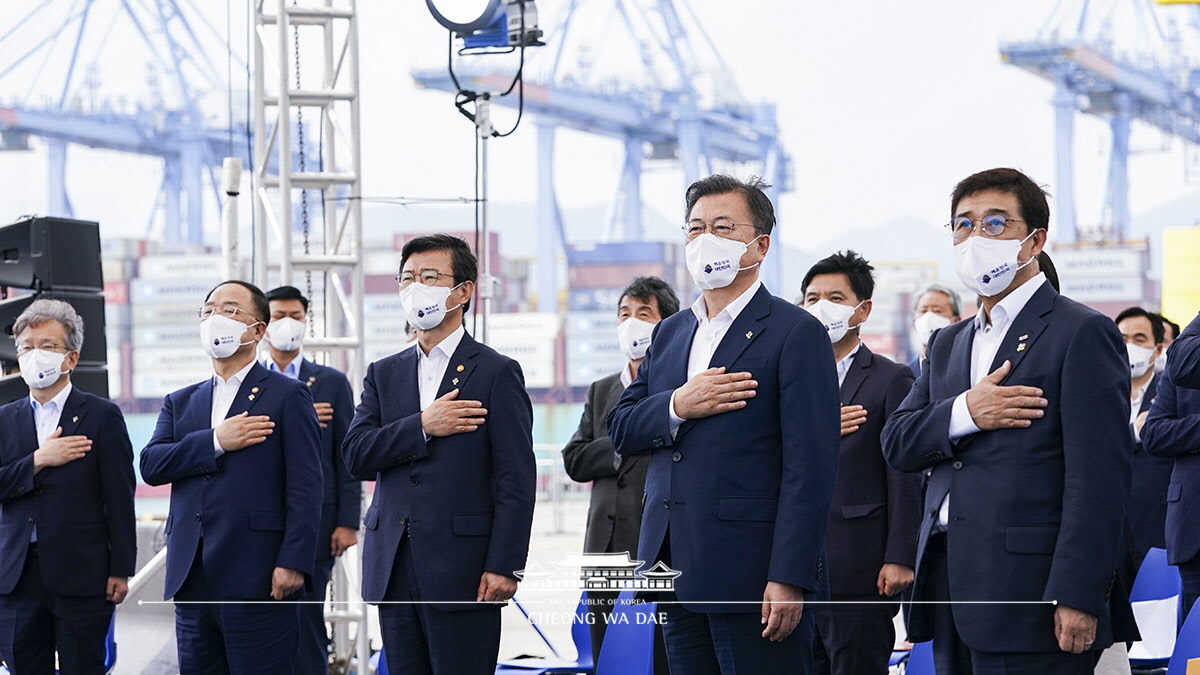이 웹사이트는 제19대 대통령 임기 종료에 따라 대통령기록관이 「대통령기록물 관리에 관한 법률」에 의해 이관받아 서비스하는 대통령기록물입니다. 자료의 열람만 가능하며 수정 · 추가 · 삭제는 불가능합니다.
다만, 「개인정보보호법」에 의하여 개인의 정보를 보호받기 원하시는 분은 관련 내용(요청자, 요청내용, 연락처, 글위치)을 대통령 웹기록물 담당자(044-211-2253)에게 요청해 주시면 신속히 검토하여 조치해 드리겠습니다. 감사합니다.
SPEECHES & REMARKS
BRIEFINGS
Remarks by President Moon Jae-in at Ceremony to Launch National Shipping Industry Leader Strategy and HMM Hanul

Fellow Koreans, citizens of Busan, representatives from the shipping and shipbuilding industries,
The Port of Busan is the world’s second largest and Northeast Asia’s largest transshipment port, handling 75 percent of Korea’s total container traffic. As the heart of the country’s shipping industry that is advancing into the global market, this port has carried Korea’s trade and economy forward. Underpinning all-time high exports, the port is now hastening our rapid economic recovery.
Three years into the start of rebuilding Korea’s shipping industry, the establishment of the Korea Ocean Business Corporation and Hyundai Merchant Marine’s order for 20 super-sized container ships have miraculously resuscitated our shipping industry. Since the world’s largest container vessel the HMM Algeciras set sail on its maiden voyage last year, container ships have continued to be loaded at full capacity. Our national pride as a shipping powerhouse has been regained.
The HMM Hanul, set to sail out to sea today, is the last vessel to join Hyundai Merchant Marine’s new fleet of 20 container ships; it completes the brilliant resurrection of Korea’s shipping industry. With the launch of the HMM Hanul, I am very pleased to present to the people the achievement of rebuilding the shipping industry as well as a vision for becoming a pacesetting nation in shipping.
Fellow Koreans,
Four years ago, a few months before my inauguration, the bankruptcy of Hanjin Shipping, the world’s seventh largest national flag carrier at that time, came as a tremendous shock. Most of the cargo volume handled by Hanjin Shipping fell into the hands of foreign shipping companies, resulting in the decrease of more than 10 trillion won in sales for Korea’s shipping industry. As many as 10,000 jobs evaporated from such interrelated up- and downstream industries as ports, shipbuilding, equipment, finance and insurance. Local economies were also hit hard. Exporters had many difficulties shipping out their goods. The decreased trust in Korea’s shipping industry and the disintegration of logistics networks built across 168 ports around the world over 40 years constituted a colossal loss that cannot be assigned a monetary value.
My Administration rebuilt the shipping industry from the ground up through a five-year plan. The Korea Ocean Business Corporation was founded to provide a total of 6 trillion won in liquidity. Having become the largest Korea-flagged shipping company, HMM placed new orders for 20 super-sized – 24,000 TEU and 16,000 TEU – container ships. In addition to that bold purchase, the company joined The Alliance, one of the world’s three largest shipping groups.
Through an innovative restructuring process, HMM recorded approximately 1 trillion won in operating profits last year and swung back into the black for the first time in ten years. This year, operating profits exceeded one trillion won for the first quarter alone, the best-ever performance since the company’s founding. As support from the Korea Ocean Business Corporation has brought management stability to small- and medium-sized as well as middle-market shipping companies, the domestic shipping industry’s total sales this year are forecast to recover to levels recorded before the bankruptcy of Hanjin Shipping.
While jointly overcoming crises, the power of mutual benefit has grown further. Through cooperation, ship owners and consignors are doing their utmost to process this year’s significantly increased export volume, and the utilization of Korea-flagged ships has risen further. Over the past three years, a total of 126 vessels ordered by domestic shipping companies have been built in the country’s shipyards, helping to revive our once-troubled shipbuilding industry.
Last year saw freight charges skyrocket due to a lack of available ships. Amid this situation, the super-sized container ships we had secured early on helped us immensely by minimizing disruption in our export logistics. Shipping companies, the shipbuilding industry, state-owned financial institutions, the Korea Ocean Business Corporation, Busan Metropolitan City, Gyeongsangnam-do Province and Busan Port Authority have all pulled together to accomplish this feat. I extend my heartfelt appreciation to all of the relevant officials who have joined forces to rebuild our shipping industry.
Fellow Koreans, representatives from the shipping and shipbuilding industries,
Now, we are going to take on even greater challenges. Along with the efforts to build larger container ships, we will seize the accelerated eco-friendly transition and digitalization of ships and ports as an opportunity for our shipping industry’s leap forward. The Government will take the initiative. By 2030, we will help secure a container cargo volume that exceeds 1.5 million TEUs to increase shipping sales to more than 70 trillion won and spearhead our emergence as a leading country in the global shipping industry.
First, we will secure competitiveness in line with the growing size of container ships. Shipping routes will be broadened to South America and Africa, and global base terminals such as those in the west coast of the United States will be expanded. To this end, we will help HMM add 12 new 13,000-TEU container ships to its fleet. The competitiveness of our shipping services will be enhanced through logistics services that connect ports, airports and railroads.
The Korea Ocean Business Corporation’s capabilities will be further enhanced. We will introduce a Korean-style ship sale and leaseback business that provides reasonable charter hire rates. Support will be provided to expand the container box leasing business so that shipping companies can raise their competitiveness. We will further boost the synergy of cooperation between shipping and shipbuilding industries and between ship owners and shippers, thereby establishing a virtuous cycle that helps each other advance.
Second, we will turn the accelerating trend of ships becoming more eco-friendly and digitalized into an opportunity for us. By investing 250 billion won to develop related technology, we will start with the commercialization of low-carbon and move on to carbon-zero vessels by 2050 and lead the global eco-friendly shipping market. Our shipbuilding industry is already spearheading the eco-friendly ship market.
The introduction of smart shipping and logistics systems will also be accelerated. Starting with the Port of Gwangyang, we will introduce an automation system to new ports such as Busan New Port and Jinhae New Port, making them exemplary smart ports. We plan to capture 50 percent of the world’s autonomous ship market by 2030 by securing related technology at the earliest date possible. As a short-term solution, temporary ships will be urgently deployed along main export routes to ease the difficulties exporters are facing from the rise in shipping rates. In particular, cargo space reserved exclusively for small- and medium-sized shippers will be further expanded.
Fellow Koreans, Busan citizens and shipping and shipbuilding industry representatives,
The Port of Busan is open toward the future. When the new airport on Gadeokdo Island is completed and trains departing from Busan someday run along trans-continental railroads, the city will become a global logistics hub covering land, sea and air, and the Port of Busan’s status as a key port in Northeast Asia will rise even further.
Today, with a blast from the HMM Hanul’s foghorn, the Republic of Korea, a pacesetting nation in shipping, powerfully sets sail from the Port of Busan. The Taegeukgi(Korean National Flag) will be flying in ports large and small around the world. As our shipbuilding industry joins forces, Korea-made ships will crisscross the ocean. Cutting through waves, the Republic of Korea will take a stronger leap forward.
Once again, congratulations on the launch of the HMM Hanul, and I wish it safe sailing.
Thank you.



